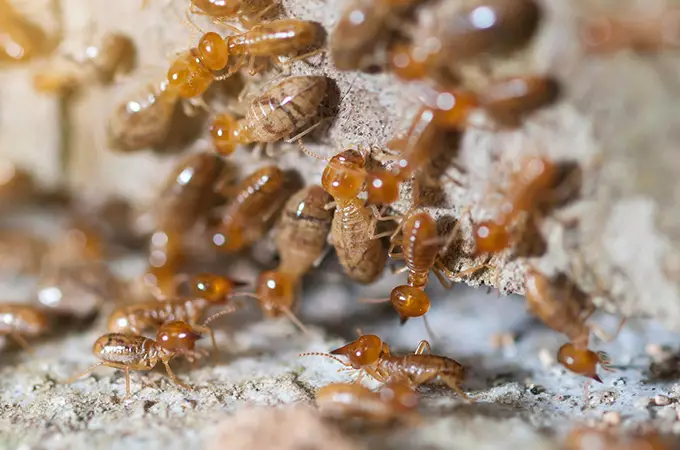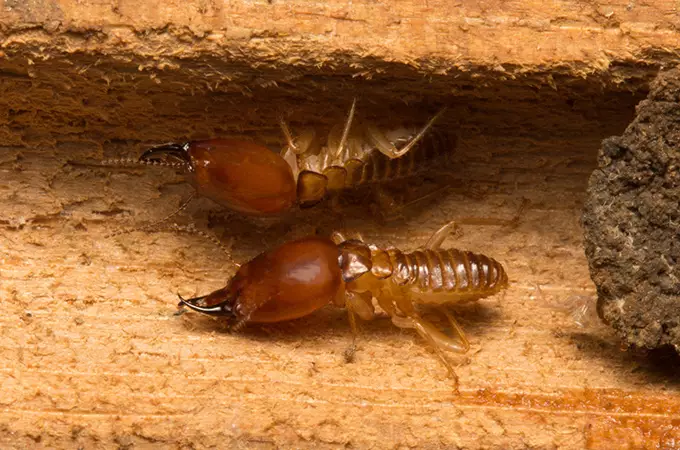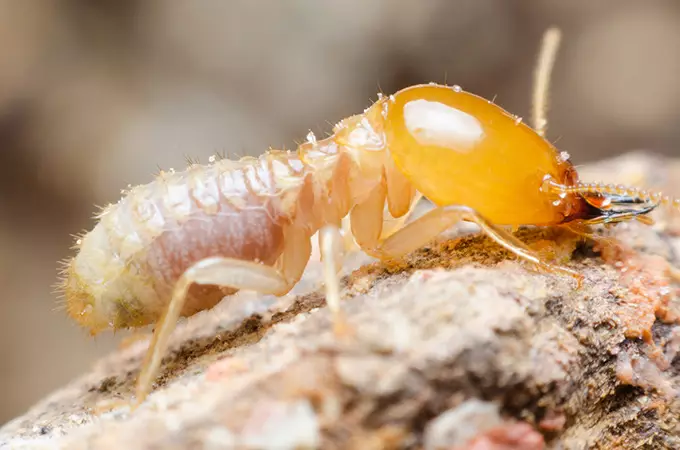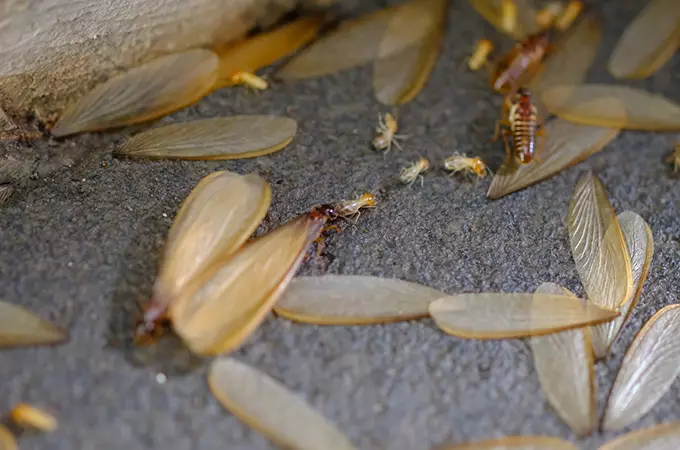Termites in florida
Pest Library
Termites are silent destroyers that cause over $5 billion in property damages each year in the United States! Termites are a significant problem in Florida due to our warm, humid weather.
Learn all about termites and how to find if you have termites here and use the button above to get in contact with us to help remove and prevent termites!
HOW TO GET RID OF TERMITES
Effective Termite Treatment Services Focus on Prevention
When termites swarm, they’re looking for places with a ready food source and enough space for a new colony. That’s why the first step in termite prevention is ridding your home of any termite-hospitable areas.
- Make sure water is draining at least 12 inches away from all structures.
- Keep wooden and stucco exterior features away from soil.
- Block all potential entry points, including cracks in the foundation and woodwork.
Termites know how to keep a low profile, so it’s often difficult to spot them once they’ve built a nest in or near your property. A certified pest-control professional has the training and experience to spot telltale signs of a termite infestation.
- The faint sound of clicking as the termites communicate with each other.
- The presence of very small holes that termites use to eject waste.
- The presence near these “kick-out” holes of waste pellets, called frass pellets.
- A hollow sound when you knock on the wood with a screwdriver or other instrument, which may indicate termite damage.
Do termites fly?
Not all termites have wings to fly, but across species, typically the reproductive termites can fly, making them extra concerning. If you’re already dealing with a termite infestation at your home, contact Nozzle Nolen right away so we can determine the best treatment plan for you.
Subterranean Termites

What do subterranean termites look like?
There are three different divisions or castes of subterranean termites in a colony:
- Workers are white, approximately 1/8” long, and wingless.
- Soldiers are slightly larger than the workers, wingless, and white or beige and have large brown heads with chewing jaws.
- Reproductives are the largest members of the colony. These 1/2” long-winged termites are responsible for enlarging the colony through mating and reproduction.
Subterranean termites are typically found in underground colonies and rarely emerge into the open, so if you’re not looking for them, they may go unnoticed until they start doing serious damage. They get around by constructing mud tubes or tunnels between nests and the wood they feed on. These mud tubes are often found in building foundations, walls, crawl spaces, basements, or building exteriors. The small, cylindrical tunnels can vary in size, but are typically about the width of a pencil or smaller, and will feel dry and brittle to the touch. If you find these tubes, that’s a sign you have a termite colony and it’s time to contact a professional for a termite inspection.
When are subterranean termites active?
Subterranean termites are active throughout the year with swarming in the spring. In Florida, they’re most active in the warm and wet months of spring and summer.
What attracts subterranean termites?
Subterranean termites live and feed in the soil, but they will also nest in wet wood. They are attracted to wood or other items that contain cellulose for food and they are attracted to light. They need moisture to survive, so areas with high humidity or water leaks like clogged gutters, leaky pipes, or poor drainage around foundations can attract them. Make sure there is no wood touching the exterior of your house or foundation.
Are subterranean termites dangerous or destructive?
These silent destroyers are very destructive to wood structures but CBS (concrete block/stucco) homes are not immune. With wood structures, they can tunnel into your home from their nest and attack any wood structure that they happen to find, which will weaken the structural integrity of your home over time.
With concrete block homes, they can tunnel between the blocks to reach the wood in your attic. They can literally eat you out of house and home, and most of the time without you knowing until it’s too late!
Repairing termite damage can be expensive, as it can involve replacing important structural elements, such as beams or framing, or even rebuilding parts of the home. Don’t wait until termite damage is done, contact Nozzle Nolen at the first sign to remove and control termites.
Formosan Subterranean

What do Formosan subterranean termites look like?
Formosan colonies are the largest colonies of the subterranean termites. Can be up to 6-7 million members in a colony! Just like the native subterranean termites, there also are three different castes in the Formosan subterranean termite colony. While these castes share the same responsibilities as the castes in the native subterranean termite colony, Formosan colony members have a few physical differences:
- Workers are small, white or off white and approximately 1/8” long.
- Soldiers are light brown with an oval shaped orange-brown head and are a little larger than the workers.
- Reproductives are yellowish-brown, 1/2” long and are sometimes winged.
When are Formosan subterranean termites active?
Formosan subterranean termites are active year-round in Florida with an increased level of activity in the spring months when they swarm to start new colonies.
What attracts Formosan subterranean termites?
Formosan subterranean termite swarmers are attracted to light and are often discovered near windows, light fixtures, porch lights, in spider webs near lighted areas, and on windowsills. These termites also feed on wood and cellulose, which can be found in plants.
Where are you likely to find Formosan subterranean termites?
Formosan subterranean termites build nests that are made up of chewed wood, soil, saliva and fecal material. These nests can be both above and below ground. The nests are typically located away from the structures that they are feasting on and can be difficult to locate.
Some common areas that you could find termites swarming include wooden structures (beams, studs, joists, etc), attics and basements, crawlspaces, and wooden porches and decks.
Are Formosan subterranean termites dangerous or destructive?
Formosan termites are the most destructive species of termites in Florida. Formosan subterranean termite nests are much larger than that of a native subterranean termite. While native subterranean termite nests have members in the hundreds of thousands, Formosan subterranean termite nests can have nests in the millions. Their sheer numbers make them a danger as an invasive pest. They are the most destructive termites in the world. These destroyers are known to eat through such things as:
- Cardboard
- Paper
- Wood
- Foam insulation boards
- Thin lead and copper sheeting
- Plaster
- Asphalt
- Some plastics
Asian Subterranean Termites

What do Asian subterranean termites look like?
- The reproductives lay the eggs. Each colony only has one pair of primary reproductives and these darker and larger termites can live for up to 20 years and lay 1,000 eggs each day, which is how their colonies get so large, so fast. They are the only ones who have eyes, the rest of the termites are blind.
- The soldiers defend their nest from invaders. This blind caste of Asian sub termites has a larger sized jaw and head to help block the tunnels of the colonies from intruders. They produce a rattling sound which is something that they do to warn off nest-mates by banging their heads against the walls of the tunnels. If the colony is large enough and the environment quiet enough, this sound can be heard in infested buildings.
Asian subterranean termites resemble their cousins, the Formosan Subterranean termites in some ways, but not in others. They have huge underground colonies, and their sheer numbers and size far surpass their Formosan cousins. They also build large mud carton nests in the walls of structures. The Asian Sub Termite has 3 distinctive castes in their colonies. - The workers work for their colony. They dig tunnels, care for the young and gather food. These small milky white termites have saw-tooth mandibles that allow them to take small bites of wood and carry it back to the nest. These are the ones actually causing the destruction.
When are Asian subterranean termites active?
Asian subterranean termites are active year-round in Florida with an increased level of activity in the spring months when they swarm to start new colonies.
What attracts Asian subterranean termites?
Swarmers of Asian subterranean termites are attracted to lights. These destructive pests like to live in dark, humid, and moist areas that offer them cellulose for food.
Where are you likely to find Asian subterranean termites?
Asian subterranean termites build their nests underground or in walls of buildings. They are particularly common in South Florida because of the warm and humid climate. Some common areas that you could find them swarming include wooden structures (beams, studs, joists, etc), attics and basements, crawlspaces, and wooden porches and decks. If you have concerns around these areas, be sure to get in contact with us to schedule a termite inspection.
Are Asian Subterranean termites dangerous or destructive?
Asian Subterranean termites are extremely destructive. These termites breed quickly and quietly. The queen can lay up to 1,000 eggs each day which causes the colony to grow very fast. They eat cellulose found in wood, so wooden structures in buildings and wood products like playground equipment and fences are on their menu.
Drywood Termites

What do drywood termites look like?
Drywood termites are small and have three separate castes within their colonies. However, unlike the subterranean termites the workers, soldiers, and reproductives are not easily distinguished. They are small with pale to light brown or cream-colored bodies and straight,
When are drywood termites active?
Drywood termites are a year round concern in Florida with an increase of activity in the spring and early summer when they swarm.
What attracts drywood termites?
As the name suggests, Drywood termites are attracted to dry wood! This can include unpainted and unsealed wood, wooden furniture, wooden structures, firewood piles, and more. They could also be attracted to damp wood as well. You can help prevent Drywood termites by sealing and painting wooden structures, storing firewood away from your home, and addressing moisture issues such as leaky roofs, plumbing issues, and poor ventilation.
Where are you likely to find drywood termites?
Drywood termites live in the wood that they are infesting. They can be found in wooden playground sets, woodpiles, wooden furniture in the wooden framework of buildings, and even on boats.
Are drywood termites dangerous or destructive?
Drywood termites are slow eaters compared to other termites, but when they get done there is almost nothing left. These termites build extensive cities within the wood that they are inhabiting and just like the subterranean termite will literally eat you out of house and home. Drywood termites can also often infest the contents of a home like the furnishings without needed contact with the soil.